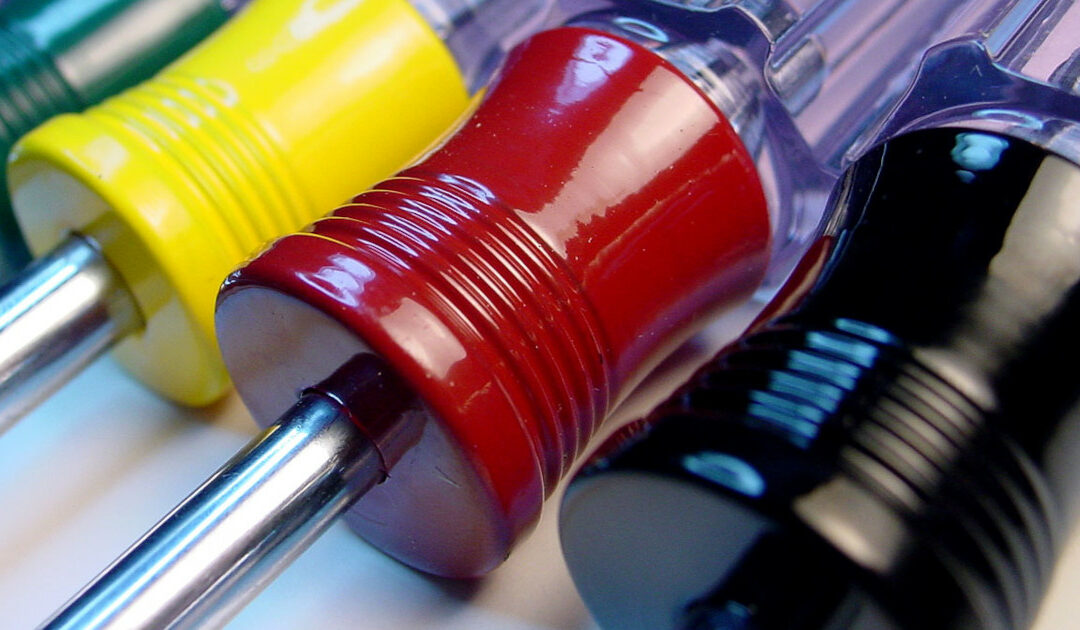Most toolkits start with the basics and build up. A simple screwdriver will get most jobs done, but there are many types and sizes to fit various applications. Having the right tool makes jobs easier, less complicated, and less dangerous.
Photo by Darren Hester.
The Right Tool
Would you use a lawnmower to trim your beard? The right tool can make the difference between a great or mediocre result. Sometimes, using the wrong tool is dangerous.
If you don’t have the right tool and you’re in a hurry, you might ask yourself, “What have I got that I could use instead?” Using the wrong tool might result in a less than perfect result or it might just send you to the emergency room.
There’s an old cliche that states every new project requires a new tool. There’s another axiom that states, “Use the right tool for the job”.
A new project sometimes results in three or four trips to the hardware store. All too often, one of those trips turns into a new tool purchase. It might even look very similar to one already found in your toolbox, belt, or hanging on the pegboard. When the “almost right” tool can’t do the job or worse, makes the job harder, the time has come to pony up for the right tool that does the job well.
The right tool becomes even more important if there’s any chance you’ll need that tool again in the future. Having the right tool also helps prevent injuries. By the same token, cheap tools may break easily and injure you or someone else in the process. When it comes to safety, the right tools always pay for themselves even if you don’t realize what you saved.
Safety Gear
When it comes to safety, there is no substitute for using the right gear. Safety goggles, safety glasses, face shields, dust masks, respirators, and leather gloves are just a beginning. Many jobs have their own safety requirements and you should know what they are before you begin.
Using the right tool can mean the difference between a great or mediocre result. Sometimes, using the wrong tool is dangerous. Kind of like using a lawnmower to trim your beard…
You only have one pair of eyes, one pair of ears, two arms, two hands, eight fingers and two thumbs.
You only have one life.
Wear the Appropriate Personal Safety Gear for the job and don’t cut corners. It could mean the difference between keeping your eye, limb, or life.
A homeowner was finishing his basement and hiring the cheapest help he could find. Cherry picking various quotes resulted in hiring different contractors to do the job in pieces while he attempted to bargain his own labor in exchange for a lower fee in order to save money.
While helping to install the suspended tile ceiling, another contractor working on an unrelated task pointed out that he should wear safety goggles. The ceiling installer, who wasn’t wearing eye protection either, pointed at some safety glasses and the homeowner put them on. The other contractor told him that glasses weren’t the right protection, but the homeowner was impatient and sharply told him the glasses were good enough.
Safety glasses are very good at protecting the eyes from flying objects that come from directly in front of you. Goggles, on the other hand, seal the eyes from dust and debris that may fall from above or come from other directions.
Within minutes of the exchange, the homeowner took a new tile from the stack and lifted it into place. A flurry of dust and debris fell off the tile when he turned it over and a chunk of gypsum fell into his eye. He ended up in the emergency room to remove it and his cornea was badly scratched.
In the end, the homeowner paid far more for his mistakes than he would have paid a good, safety conscious contractor or even invested in his own personal safety equipment—protective goggles, a respirator face mask, and gloves worn with a long sleep shirt.
It was a lesson in using the right tool for the job—in this case safety equipment. The homeowner paid the deductible for the ER visit, plus the deductible for a visit to his eye doctor, plus the prescription eye drops. On top of that, because the guy who framed the basement and put up the drywall cut a lot of corners, the ceiling installer charged almost sixty percent over the original quote because it took much longer to attach the wall angle to support the ceiling grid.
Hiring the cheapest bidder, then pushing the contractor to lower the cost even further ended up costing the homeowner more money. than if he had hired the right people in the first place. The final result looked okay, but when it came time to sell the home, the homeowner ended up hiring an electrician and a plumber to correct the shortcuts. The electrician had to cut holes in the drywall, and the plumber had to remove fixtures and cut holes in drywall to accomplish the repairs.
